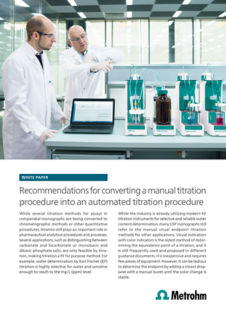What is thermometric titration?
In contrast to potentiometric titration, where a potential change is measured, thermometric titration measures the temperature change in the titration solution that results from the reaction enthalpy.
Every chemical reaction is accompanied by a change in enthalpy, meaning that, as long as a reaction takes place, there is either an increase (exothermic reaction) or decrease (endothermic reaction) in the temperature of the titration solution. This technique can therefore be applied for difficult samples or matrices where potentiometric titration is difficult or not feasible such as the determination of sodium, the acid number, or base number.
What are the advantages of thermometric titration?
- Problem solver for difficult samples that cannot be titrated with potentiometric titration
- Only one temperature sensor is needed for all applications - no sensor calibration or maintenance required
- Robust method for routine work
- Rapid results
Would you like to know more about thermometric titration?
Read our blog article “Thermometric titration – the missing piece of the puzzle”












